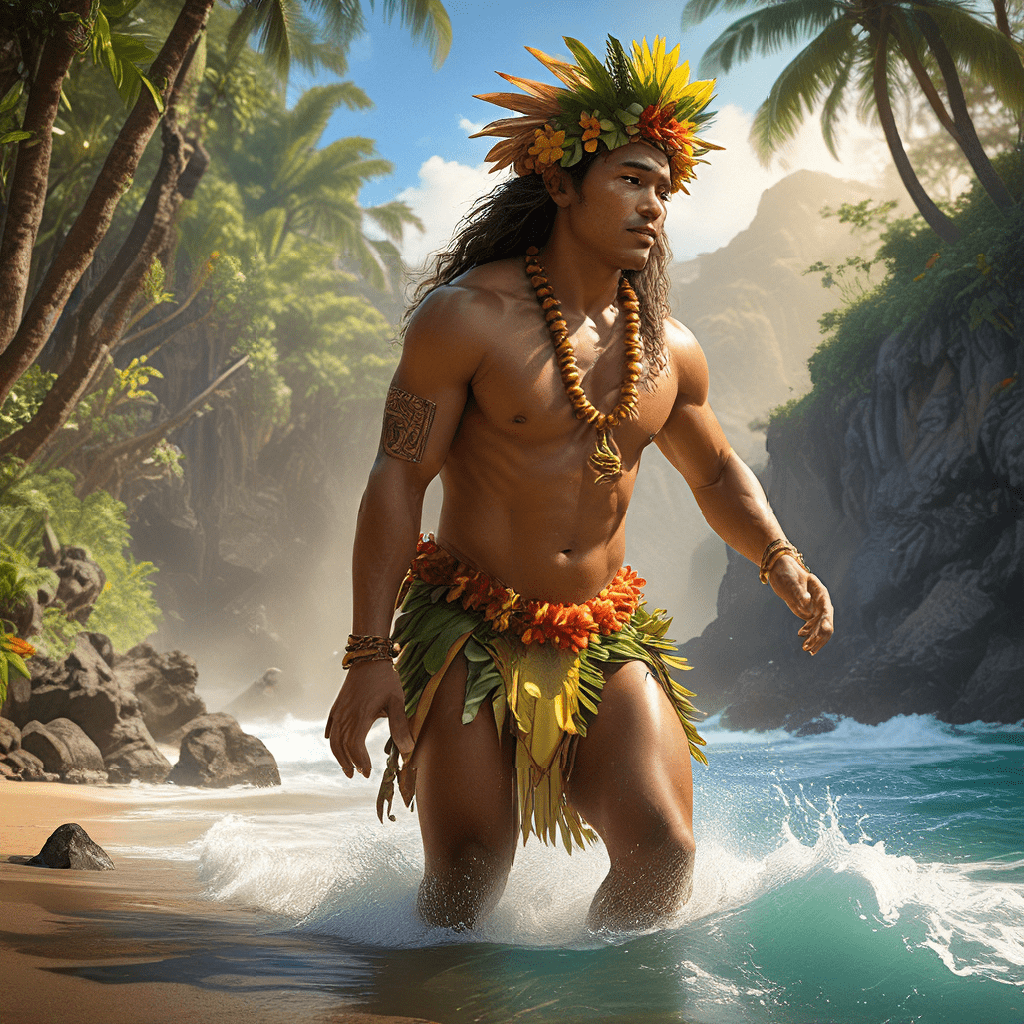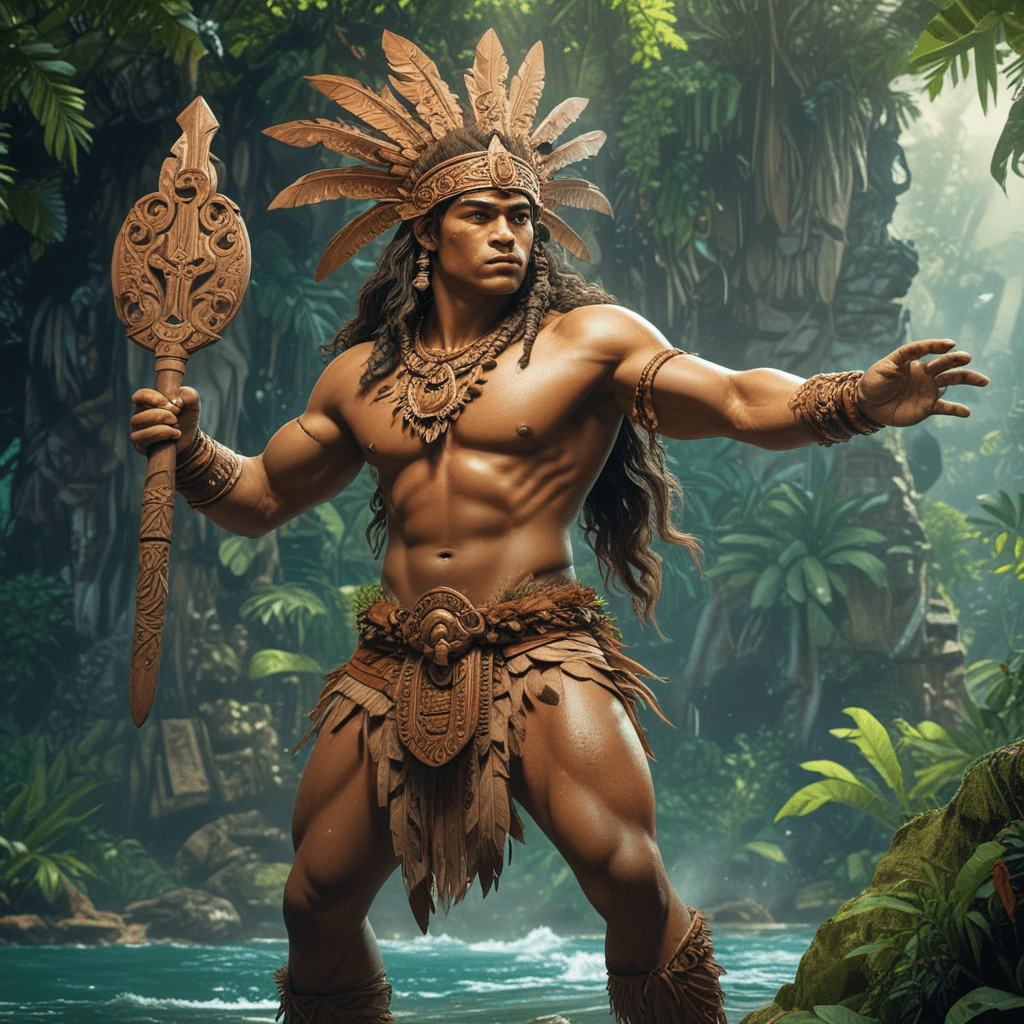Hawaiian Creation Myth: A Divine Narrative
The Hawaiian people have a rich and vibrant mythology, filled with stories of gods, goddesses, and heroes. These myths, passed down through generations, provide a framework for understanding the world and their place in it. The most central creation myth, known as "Kumulipo," tells the story of the world's creation and the emergence of the Hawaiian people.
The myth begins with "Po," the primal darkness, from which everything originated. From "Po" emerged "Wakea," the sky father, and "Papa," the earth mother. Their union gave rise to the islands of Hawaii and all the life that inhabits them. Wakea and Papa created the first humans, who were gifted with intelligence, creativity, and the ability to learn and adapt.
These myths serve as a testament to the Hawaiian people's deep connection to their land and their ancestors. They offer a unique perspective on creation and the origins of life, placing humans as integral parts of the natural world, not separate from it.
The Role of the Gods in Hawaiian Mythology
The Hawaiian pantheon is rich and diverse, featuring a cast of gods and goddesses who represent different aspects of nature and human life. Each deity holds a unique role and significance within the mythology.
- Kū: The god of war, strength, and agriculture.
- Kāne: The god of creation, fertility, and life.
- Lono: The god of peace, prosperity, and agriculture.
- Kanaloa: The god of the sea, the underworld, and death.
- Hina: The goddess of the moon, fertility, and women.
These gods are not merely distant and abstract beings. They are active participants in the world, influencing the weather, the harvest, and the lives of the Hawaiians. Their actions and stories offer guidance, lessons, and warnings for the people.
For example, the story of Pele, the goddess of fire and volcanoes, teaches about the power and danger of nature. It also highlights the need for respect and understanding when interacting with the natural world.
The Four Major Islands: A Gift from the Gods
The four major islands of Hawaiʻi, Maui, Oʻahu, and Kauaʻi, are believed to have been formed by the gods. According to legend, these islands were gifts from the gods to the early Hawaiians, who were tasked with caring for and protecting them.
The island of Hawaiʻi, the largest and youngest of the main islands, is believed to have been created by the goddess Pele. It is said that she journeyed from Tahiti to Hawaiʻi, bringing fire and volcanic activity to the islands. Her fiery eruptions shaped the landscape, creating the volcanic peaks and fertile soils that define Hawaiʻi today.
The island of Maui, home to the majestic Haleakala volcano, was also formed by volcanic activity. According to legend, Maui, the demigod of the island, used his magical fishhook to pull the island from the sea. The hook represents the power of knowledge and skill, and the act of pulling the island from the sea symbolizes the Hawaiians' ability to overcome challenges and create a thriving society.
The Origins of the Hawaiian People: From the Stars and the Sea
The Hawaiian people believe that their ancestors traveled from the stars and the sea. While the exact origins are not fully known, many believe that the Hawaiians embarked on daring voyages from distant islands in the Pacific Ocean, navigating by the stars and the currents.
According to oral traditions, the Hawaiians journeyed from distant lands like Tahiti, Aotearoa (New Zealand), and Samoa. They are said to have been guided by their ancestral knowledge, their bravery, and their deep connection to the sea.
The journey to Hawaiʻi was long and perilous, but the Hawaiians persevered, venturing across the vast expanse of the Pacific Ocean in search of new lands. These ancient voyages are a testament to their resilience, their adventurous spirit, and their ability to adapt to new environments.
The Importance of Ancestry and Lineage in Hawaiian Culture
Ancestry and lineage play a crucial role in Hawaiian culture. The Hawaiians place great importance on knowing their genealogy and tracing their lineage back to the gods. This knowledge helps to define their identity and connect them to their past.
The Hawaiian word "ʻohana" translates to "family," but it encompasses a much broader concept. It refers to the extended family, including ancestors, descendants, and even those who are not blood relatives but are considered part of the family through shared experiences and connections.
The concept of ʻohana emphasizes the importance of community, cooperation, and mutual support. It highlights the interconnectedness of all people and the responsibility each individual has to care for and support their community.
The Kumulipo: A Genealogical Chant Tracing Ancestry to the Gods
The "Kumulipo" is a sacred genealogical chant that traces the lineage of the Hawaiian people back to the gods. This chant, passed down through generations, is a vital part of Hawaiian culture and history. It provides a deep understanding of their origins, their connection to the natural world, and their place in the universe.
The "Kumulipo" begins with the creation of the universe from darkness ("Po"). It then details the emergence of the first gods, Wakea and Papa, and the birth of their children, including the first humans. The chant continues to trace the lineage of the Hawaiian people through generations, connecting them to the gods and the land.
The "Kumulipo" is a powerful and complex chant, filled with symbolism and meaning. It weaves together stories of creation, lineage, and the interconnectedness of life. It serves as a reminder of the Hawaiians' deep connection to their past, their ancestors, and their place within the universe.
The Polynesian Triangle: Connecting the Islands of the Pacific
The Polynesian Triangle is a region in the Pacific Ocean that includes the islands of Hawaiʻi, New Zealand, and Easter Island. These islands are connected by a shared culture, language, and history. The Hawaiians, along with other Polynesian peoples, are believed to have originated from this triangle, eventually migrating outwards to settle new lands.
The Polynesian Triangle is a fascinating area of study for researchers and historians. It provides evidence of the ancient seafaring skills of the Polynesians and their ability to navigate vast distances across the ocean. It also highlights the interconnectedness of the islands and the shared cultural heritage of the Polynesian peoples.
Through their voyages of exploration and settlement, the Polynesians established a network of islands and communities across the Pacific Ocean. This network enabled the exchange of ideas, knowledge, and cultural practices, contributing to the rich and diverse tapestry of Polynesian culture.
Voyages of Exploration: Navigating the Seas to New Lands
The Hawaiians were exceptional navigators, utilizing a complex system of celestial navigation, observation of natural phenomena, and knowledge of ocean currents. They skillfully navigated vast distances across the Pacific Ocean, venturing to new lands and establishing thriving communities.
These journeys were not mere expeditions of exploration; they were spiritual journeys that connected the Hawaiians to their ancestors and their gods. They believed that the sea was sacred and that their voyages were guided by divine intervention.
Their canoes, often crafted with incredible skill and artistry, were not just modes of transportation; they were extensions of their culture and their worldview. They represented the Hawaiians' connection to the sea, their ingenuity, and their ability to adapt to new environments.
These voyages of exploration continue to inspire awe and admiration today. They stand as a testament to the Hawaiians' courage, their ingenuity, and their enduring connection to the sea.
Theories on the Arrival of the Hawaiians: Ancient Stories and Scientific Evidence
The arrival of the Hawaiians to the islands remains a subject of ongoing research and debate. While ancient narratives provide valuable insights into their origins, modern science offers additional evidence.
Archeological evidence suggests that the first humans arrived in Hawaiʻi around 1500 AD. However, the precise origins of these settlers are still a mystery. Some researchers believe that the Hawaiians may have traveled from Tahiti or the Marquesas Islands, while others posit that they originated from Samoa or other islands in the Pacific.
Genetic studies have also provided valuable information. They suggest that the Hawaiians are closely related to other Polynesian peoples, especially those from the Marquesas Islands. However, these studies have also revealed genetic markers that are unique to the Hawaiians, suggesting that they may have intermingled with other populations during their travels.
The Enduring Legacy of the Mythical Origins: Inspiring Culture and Identity
The mythical origins of the Hawaiian people continue to inspire their culture and identity today. The stories passed down through generations provide a framework for understanding their place in the world, their connection to the land, and their relationship with the divine.
These myths serve as reminders of the Hawaiians' resilience, their adventurous spirit, and their deep connection to the natural world. They inspire respect for the environment, honoring ancestors, and a strong sense of community.
The mythical origins, along with the traditions and practices that have been passed down through generations, continue to shape the Hawaiian worldview. They offer a unique perspective on creation, ancestry, and the interconnectedness of life, inspiring a deep sense of pride and belonging.
FAQ
Q: What is the most important creation myth in Hawaiian culture?
A: The most important creation myth is known as "Kumulipo," which is a genealogical chant tracing the lineage of the Hawaiian people back to the gods.
Q: Where did the Hawaiians come from?
A: The exact origins of the Hawaiians are unknown, but most believe they traveled from distant islands in the Pacific Ocean, possibly from Tahiti, Aotearoa (New Zealand), or Samoa.
Q: What evidence supports the theory of Hawaiian origins?
A: Oral traditions, archaeological evidence, and genetic studies all support the theory that the Hawaiians are descendants of Polynesian peoples who migrated to the islands.
Q: How important is ancestry and lineage in Hawaiian culture?
A: Ancestry and lineage are vital to Hawaiian culture. The Hawaiians place great importance on knowing their genealogy and tracing their lineage back to the gods.
Q: What are some of the important gods and goddesses in Hawaiian mythology?
A: Some of the important gods and goddesses in Hawaiian mythology include Kū, Kāne, Lono, Kanaloa, and Hina. Each deity represents different aspects of nature and human life.
Q: What is the "Polynesian Triangle"?
A: The Polynesian Triangle is a region in the Pacific Ocean that includes the islands of Hawaiʻi, New Zealand, and Easter Island. These islands share a common cultural heritage and are considered the origin of many Polynesian peoples.
Q: What makes the "Kumulipo" so important?
A: The "Kumulipo" is a sacred genealogical chant that connects the Hawaiians to their ancestors, their gods, and the natural world. It is a powerful and complex chant that provides a deep understanding of their origins.



